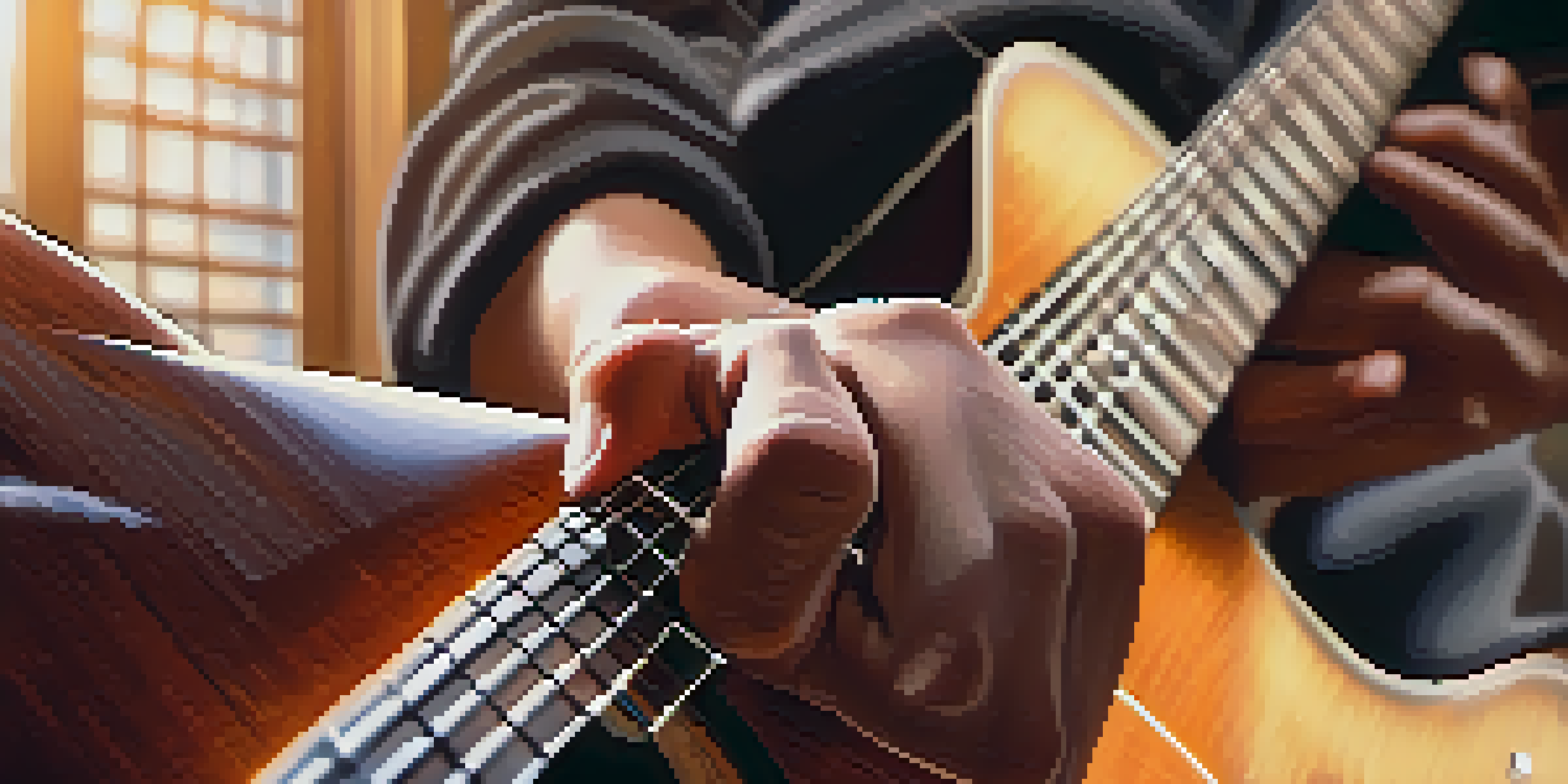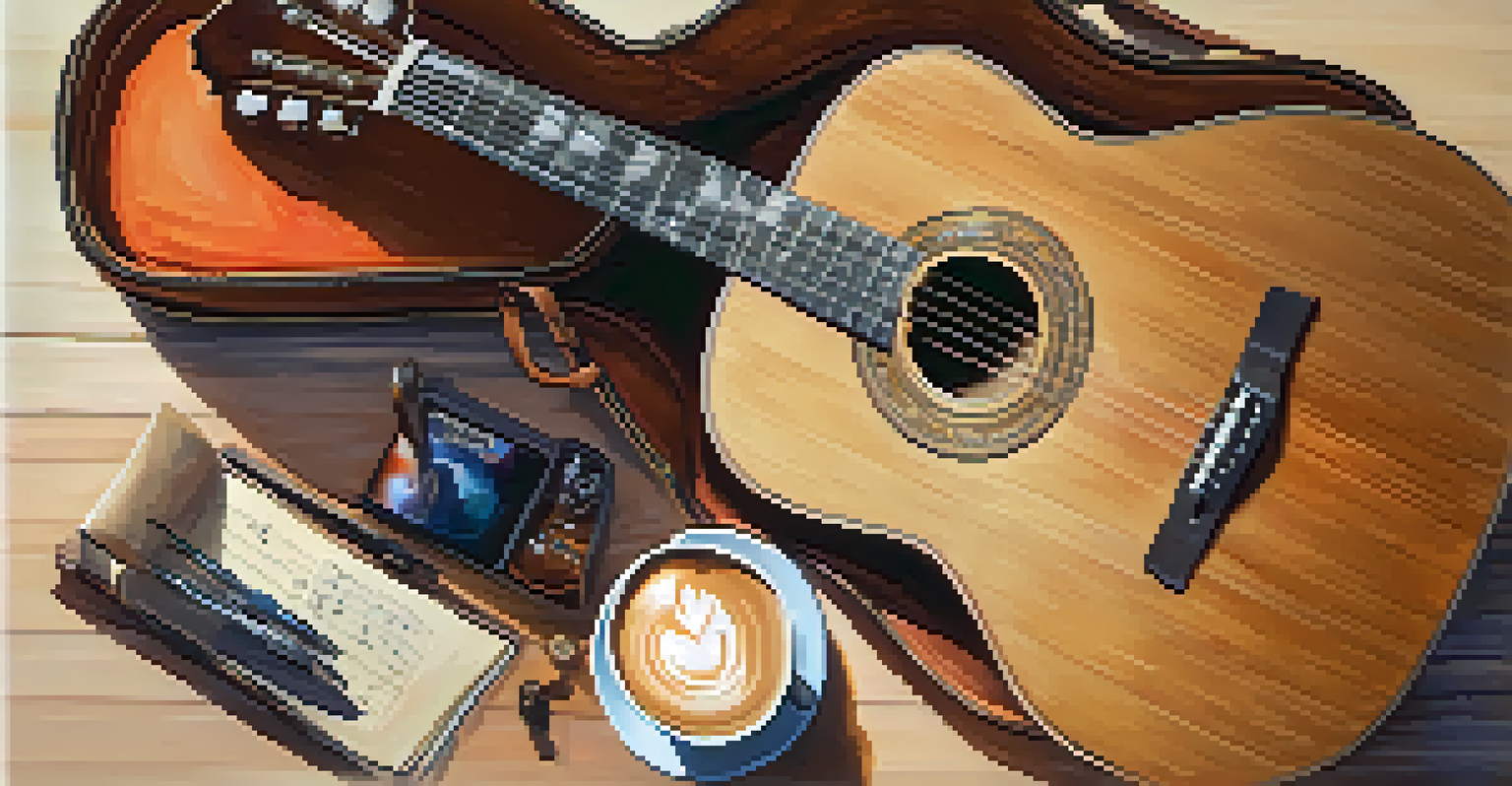Fingerstyle Techniques: A Deep Dive into Unconventional Methods

Introduction to Fingerstyle Guitar Techniques
Fingerstyle guitar is a captivating way to play, allowing musicians to explore a variety of sounds and textures. Unlike traditional picking, fingerstyle involves plucking the strings directly with your fingers, which can create a more intimate and nuanced sound. This section will provide an overview of fingerstyle and its significance in different music genres, from folk to classical.
Music is the shorthand of emotion.
Many guitarists gravitate towards fingerstyle for its versatility; it enables players to combine melody and harmony seamlessly. It’s like having an entire band at your fingertips, where the thumb plays the bass line and the fingers weave in melody and chords. By the end of this section, you’ll appreciate the rich history of fingerstyle and its modern adaptations.
As we embark on this deep dive into unconventional techniques, prepare to explore methods that may challenge your current playing style. From percussive elements to harmonics, these techniques can broaden your musical palette and enhance your overall performance.
Understanding Basic Fingerstyle Techniques
Before diving into unconventional methods, it’s essential to master basic fingerstyle techniques. Common approaches include the classic Travis picking pattern, where the thumb alternates between bass notes while fingers play melodies. This rhythmic foundation will serve as a launching pad for more advanced techniques.

Consistency is key in mastering these basics. Practicing simple patterns repetitively can help develop muscle memory, allowing you to play more fluidly. Think of it as building a strong foundation for a house; without it, the structure may not stand tall for long.
Mastering Basic Fingerstyle Techniques
Building a solid foundation with basic fingerstyle techniques is crucial for developing fluidity and confidence in your playing.
Once you feel comfortable with the basics, you can start experimenting with variations and combining different techniques. This exploration is crucial for finding your unique voice within the fingerstyle genre.
The Art of Palm Muting in Fingerstyle
Palm muting is a technique often associated with rock and heavy metal, but it can also add depth to fingerstyle playing. By lightly resting your palm on the strings near the bridge while you pluck, you can create a muted, percussive sound that enhances rhythm. This technique transforms your playing from melodic to dynamic.
The guitar is a miniature orchestra in itself.
Incorporating palm muting into your fingerstyle repertoire allows for exciting contrasts within your music. Imagine a song that alternates between soft, melodic passages and sharp, staccato sections—palm muting can help achieve that effect. It’s a great way to keep your audience engaged and guessing.
To practice, try incorporating palm muting into your favorite fingerstyle pieces. Start slow, focusing on maintaining a consistent rhythm, and gradually increase your speed as you become more comfortable. You’ll find that this technique adds a whole new dimension to your playing.
Exploring Harmonics in Fingerstyle Guitar
Harmonics are an enchanting addition to fingerstyle guitar that can really captivate your audience. They are produced by lightly touching the string at specific points while plucking, creating a bell-like tone. This ethereal quality can enhance your musical storytelling, allowing for moments of beauty and intrigue.
There are various types of harmonics, including natural and artificial harmonics. Natural harmonics occur at certain fret locations, while artificial harmonics involve fretting a note and then lightly touching the string higher up. Both can be seamlessly integrated into your fingerstyle arrangements to add texture and complexity.
Enhancing Sound with Harmonics
Incorporating harmonics into your fingerstyle guitar can create captivating, bell-like tones that enrich your musical expression.
Start by practicing harmonics on open strings before moving to fretboard notes. As you become comfortable, experiment with incorporating them into your existing pieces. The result will be a richer, more dynamic sound that showcases your creativity.
Incorporating Percussive Techniques into Your Playing
Percussive techniques are a fantastic way to add rhythm and energy to your fingerstyle guitar. By slapping or tapping on the body of the guitar while playing, you create a unique sound that mimics a drum beat. This approach can bring a lively, engaging element to your performances, essentially turning your guitar into a mini percussion ensemble.
Many artists have experimented with percussive fingerstyle, blending traditional melodies with rhythmic beats. Think of it as creating a conversation between melody and rhythm, where each enhances the other. This duality can make your music more compelling and enjoyable to listen to.
To get started, try incorporating simple taps or slaps while you play familiar tunes. As you gain confidence, you can develop more complex patterns that interweave with your melodies, enriching your overall sound.
Utilizing Alternate Tunings for Unique Sounds
Alternate tunings can open up a world of creativity for fingerstyle guitarists. By tuning your strings to different pitches, you can discover new chord voicings and melodies that wouldn't be possible in standard tuning. This technique allows you to explore fresh sounds and can inspire original compositions.
Many well-known musicians have embraced alternate tunings, such as DADGAD or Open G, to create signature sounds. These tunings often lend themselves well to fingerstyle playing, enhancing the harmonic richness of your music. Imagine the difference between a familiar recipe and a new culinary twist; alternate tunings can be that exciting change.
Creativity through Alternate Tunings
Exploring alternate tunings allows fingerstyle guitarists to discover unique sounds and inspire original compositions.
To experiment, choose a few alternate tunings and play around with them. You’ll be surprised at how they can reshape your approach to fingerstyle playing, leading to unique musical discoveries along the way.
Combining Techniques for Advanced Fingerstyle Playing
As you become more comfortable with various fingerstyle techniques, the next step is to combine them creatively. Mixing methods such as harmonics, palm muting, and percussive elements can result in a captivating and diverse sound. This blending allows you to express your musical identity more fully.
Think of it like a painter mixing colors to create a masterpiece; each technique adds a different hue to your music. You can craft intricate fingerstyle pieces that showcase your skills and emotions, making each performance a unique experience for your audience.

Start by selecting a few techniques that resonate with you, and begin experimenting with them in your playing. Over time, you’ll develop a signature style that reflects your personality and musical journey.